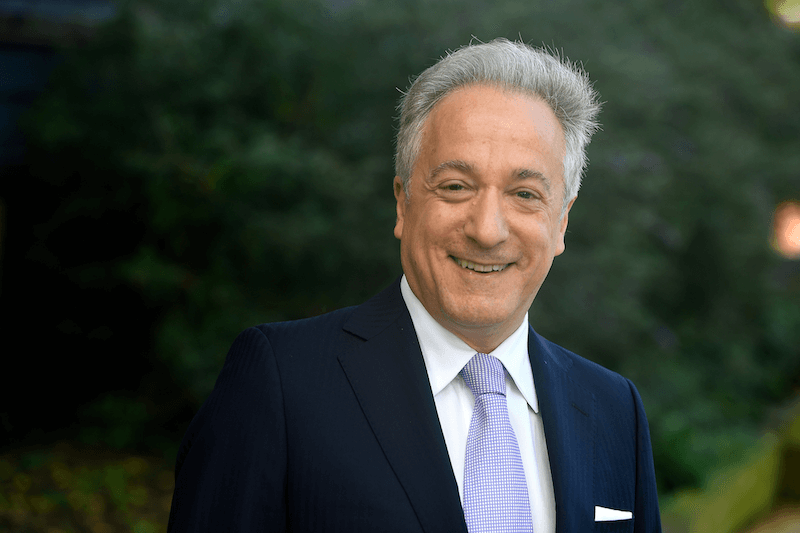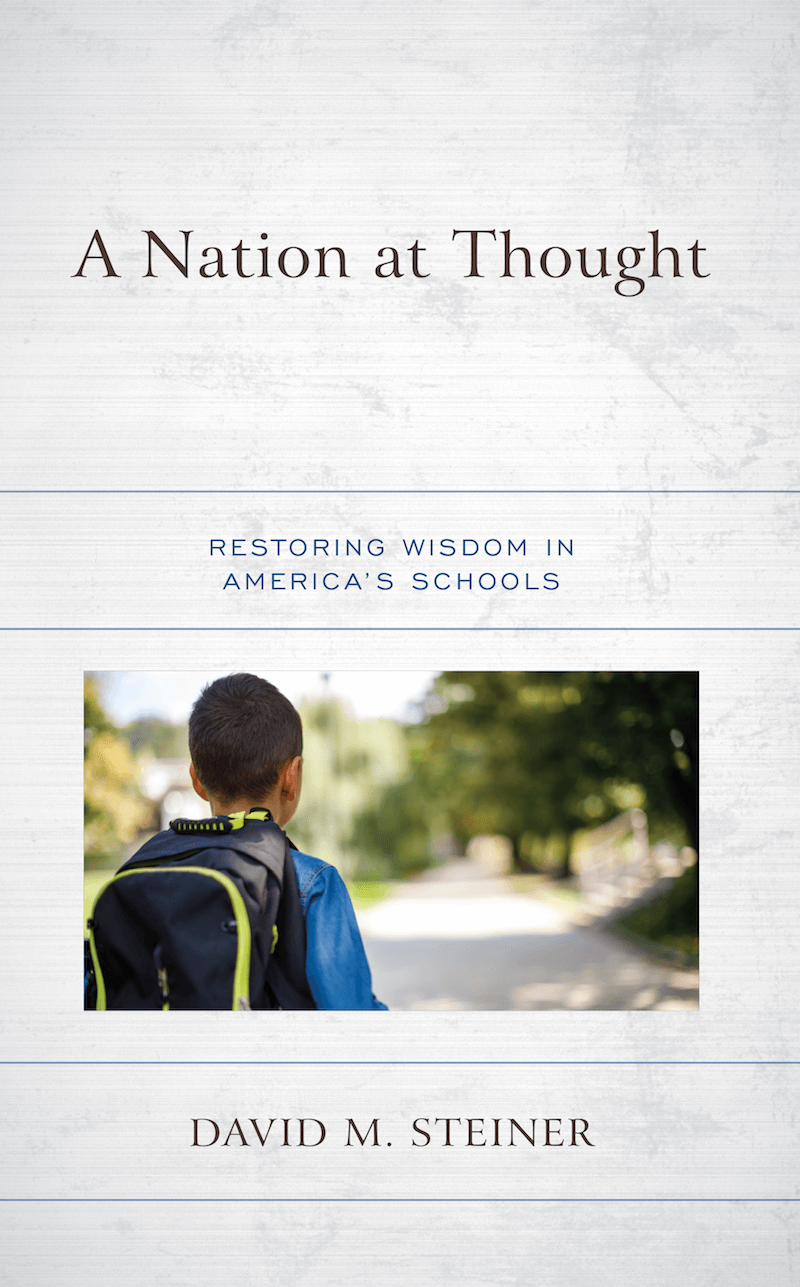David Steiner, the executive director of the Institute for Education Policy at Johns Hopkins University, has written a new book, A Nation at Thought: Restoring Wisdom in America’s Schools. I first got to know David two decades ago, when I talked him into writing a chapter that took a hard look at course syllabi in teacher preparation (for the 2004 book A Qualified Teacher in Every Classroom?). His reward for a pioneering analysis was to become a pariah in education school circles. But this didn’t stop his career in education: David became the director of arts education at the National Endowment for the Arts, returned to academe as the dean of Hunter College’s school of ed., and then served as New York’s education commissioner. Meanwhile, Kate Walsh, one of my co-editors on that 2004 book, launched the National Council of Teacher Quality, which earned big headlines when it supersized his scrutiny. The publication of his new book seemed like a good chance to talk with David about schooling, wisdom, and the changed educational landscape. Here’s what he had to say.

Hess: You’re out with a new book, A Nation at Thought: Restoring Wisdom in America’s Schools: What prompted you to write it?
Steiner: First, observations: I had too many visits to schools in which elementary-aged children were alive with energy and curiosity, while older students were visibly listless, bored, or acting out. And second, research: understanding how our nation’s academic standards, assessments, and teacher-preparation programs work against rigorous and compelling instruction. For example, the major 5th and 10th grade standards in English/language arts are practically identical: “Determine the meaning of words.” At the core of these standards is the requirement to find the main idea in each text. But after doing so a hundred times a semester, it’s tough to be excited about reading the next book. The architect of our ELA standards has said the skill set of a strong reader is that of a detective. This sounds intriguing: Should we transform a novel or play into a crime scene? But what would it mean to “solve” The Bluest Eye or War and Peace? Can we answer why Hamlet prevaricated by circling the “correct response” in a multiple-choice test? We need to re-evaluate our standards to foster engaging responses from students when they read these books.
Hess: The subtitle is Restoring Wisdom in America’s Schools: What do you mean by “wisdom”?
Steiner: ChatGPT tells us it’s the ability to make sound judgments and exhibit practical knowledge. I say it’s having one’s mind furnished with the riches of our collective culture—the active recall of scientific knowledge, paintings, film, music, poetry, and narratives from fiction and nonfiction—past and present. This makes sound judgments possible, rendering us more thoughtful. We spend more of our life with ourselves than with anyone else. When we have only our minds as interlocutors, what is the quality of that private discourse? The gift of an education in wisdom is that our inner dialogues are worth having, meaning we won’t be a complete bore to ourselves.
Hess: You say that American education lost its way when it turned away from the academic core. Can you say a bit about what you have in mind?
Steiner: Understandably disillusioned by too many failed efforts at education reform, we started by shooting the messenger—deciding that test results don’t matter—and simultaneously became fascinated by shiny new goals: metacognitive thought, positive mindset, 21st-century skills, and creative thinking. The research base supporting our focus on these goals is far weaker than most educators assume. Social and emotional well-being is important: We absolutely need mental health counselors for distressed children and supportive, responsive teaching that is simultaneously exacting and demanding from our teachers. Research on SEL has produced a small number of useful findings, such as the importance of a child making a trusting connection with an adult in the school. But arguing that, after millennia of pedagogy, we have suddenly discovered a new science simply isn’t justified.
Hess: That sounds appealing, but just what does “teaching that is simultaneously exacting and demanding from our teachers” look like in practice?
Steiner: First, it starts with teachers’ deep disciplinary knowledge and love for their subject matter. It’s impossible to teach what one doesn’t know and tough to convey effectively what one finds dull. When teachers are passionate about sharing content, that passion is infectious. Second, we need to help teachers not to teach down to children from marginalized communities. All students will rise to rigorous and passionate teaching if it is offered to them. Finally, as a society, we need to stop telling ourselves that we can replace academic mastery with critical thinking about nothing in particular.
Hess: You write, “If you wanted to design an education system for failure, what we’ve got is pretty close.” What do you mean by that?
Steiner: Three of the major pillars of our education system—how we prepare teachers, what we test, and what they teach—embody industries that exist in their own bubble. Teachers are given a curriculum to teach that they have never or barely seen before. Our ELA tests don’t evaluate what students read and instead reward the affluent for their greater levels of background knowledge. Too many of our teachers are taught to act as DJs, curating individual playlists of materials from Google, thus ensuring that a child’s education is a matter of random luck. As a whole, our system is siloed and incoherent, and then we are surprised when students have trouble learning.

Hess: You also suggest that we’ve fooled ourselves into thinking that things are getting better—in terms of GPA and graduation rates. What makes you say that?
Steiner: We have assumed that 20 years of rising high school GPAs and graduation rates, stronger 4th grade reading results, and higher numbers of Americans graduating from college mean that American schooling is doing something fundamentally right. But it isn’t: As 12th grade NAEP results indicate, our high school seniors are doing no better than they did two decades ago. Grade inflation—both in high schools and institutions of higher education—ensures that we now count as success what was once considered failure. Are there extenuating explanations for flat outcomes? Well, from 2002 to 2020, inflation-adjusted per-pupil expenditure rose. While the percentage of children receiving lunch support also rose, child-poverty rates in 2000 and 2020 were the same. Yes, certain states wrongly underfund the education of underprivileged students, and the rising number of English-language learners is educationally challenging, although only 4 percent of NAEP’s 2019 12th grade reading test-takers were ELL students. But on balance, flat results mean what they say. We need to stop wishing away evidence of no progress.
Hess: We’ve talked a lot about the challenges. So, what needs to be done? What are a few of the key steps when it comes to doing better?
Steiner: In pre-K education, we need to learn from what has and hasn’t worked with Head Start and benefit from international experience to create both scale and quality control. Then, we need to shift our teaching and testing from a damaging overemphasis on so-called “skills” to a focus on rich content and conceptual understanding. We should replace the isolation of one teacher in one classroom with team teaching under the guidance of properly compensated master teachers. We need a new school calendar to reduce summer melt. Finally, we should expand the list of subjects that can count for children’s futures: High school students should be able to study such disciplines as the arts, graphic design, statistics, environmental science, and foreign languages and to link success in their studies directly to college entrance and/or future employment.
Hess: If I’m a public official or educational leader and this resonates, how do I get started?
Steiner: First, align the instructional core. You should create knowledge-based standards; insist on high-quality, content-rich instructional materials; provide assessments that test mastery of those materials; attract a diverse teaching core; and provide a full year of clinical preparation to teach those materials under the supervision of well-prepared mentors. Second, attend to the bookends. You should close the early opportunity-to-learn gaps and create opportunities for high school students to study a wider array of subject matter. Finally, stop playing political football with education. Instead of culture wars, transmit what is finest in our multicultural inheritance and educate children to be thoughtful guardians and informed inventors of our collective future.
